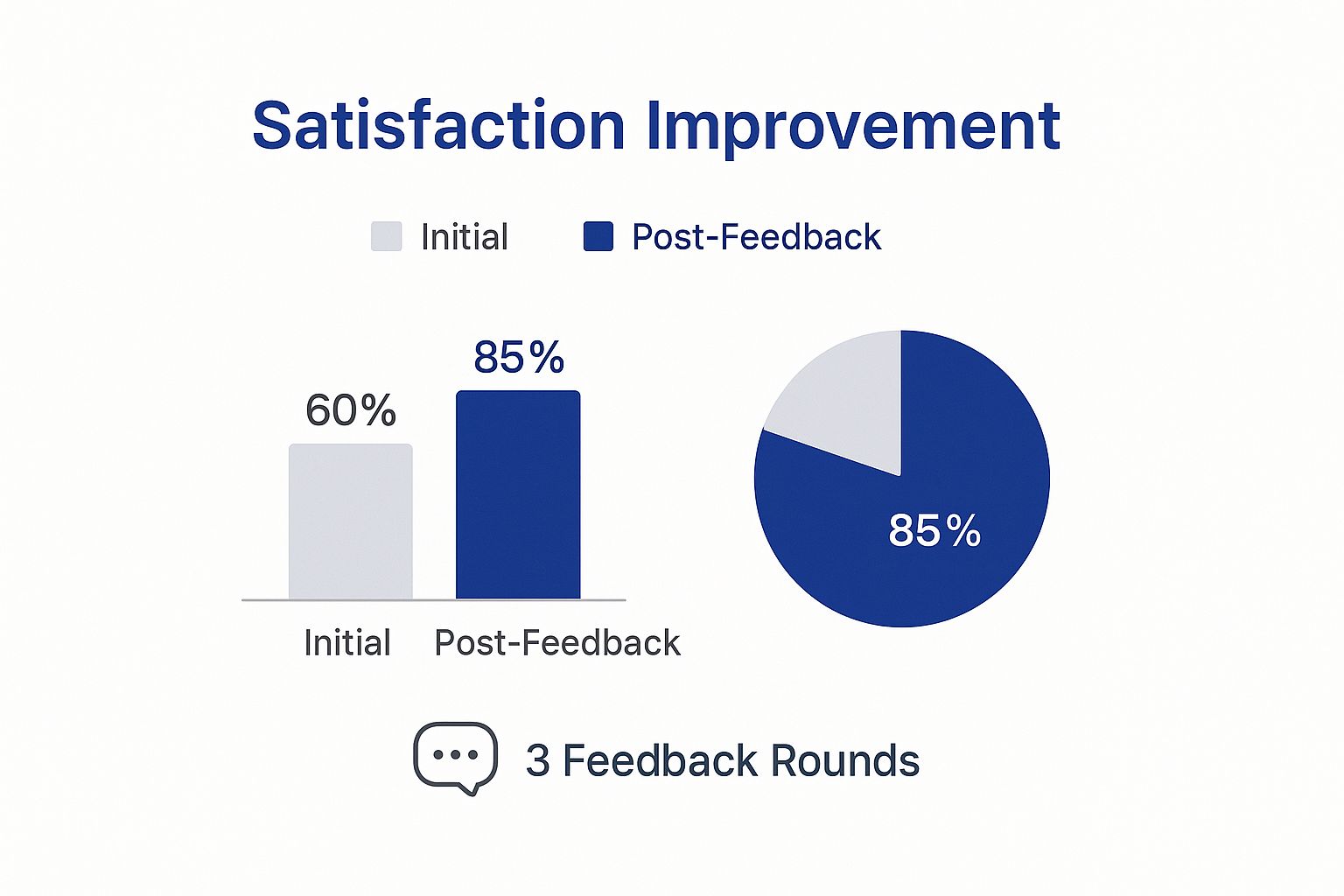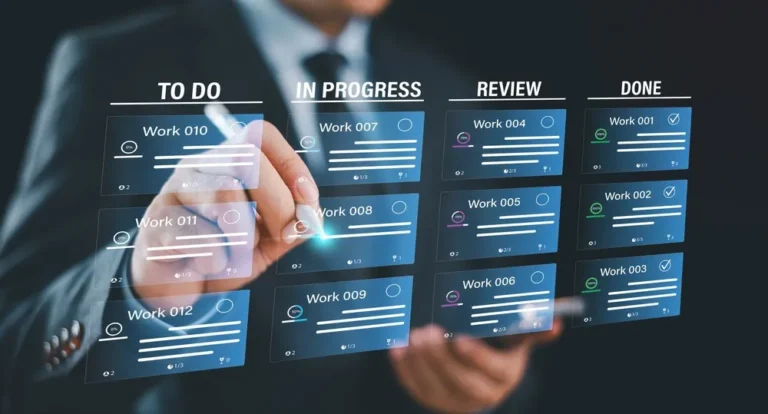Why Your Design Feedback Process Makes or Breaks Success

In the world of design, feedback is essential. It's the driving force behind impactful creations. A well-structured design feedback process fuels the entire design journey, from initial concept to the final product. Leading design teams prioritize systematic feedback approaches for a reason: they consistently deliver outstanding results and boost business outcomes.
This isn't just about making things look pretty. It has a direct impact on your bottom line. Imagine a product launch delayed by last-minute design changes. This is a common, and costly, scenario. A robust feedback loop can drastically shorten development cycles and significantly boost user satisfaction. It's like a compass, guiding designers toward solutions that truly resonate with their target audience. Early and frequent feedback prevents costly rework later.
What happens when feedback goes unaddressed? The costs can be significant. A 2024 study by Colab Software revealed that a staggering 43% of design review feedback goes untracked and unaddressed globally. Even more concerning, 90% of companies report project postponements caused by late-stage design alterations. Find more detailed statistics here. This highlights the critical need for effective tools and processes for capturing and managing feedback. Ignoring feedback is like navigating without a map – you'll eventually get there, but it will be a much longer and more difficult journey.
The Value of Structured Feedback
Top-performing design teams understand the strategic advantage of a structured feedback process. They transform potentially chaotic input into a valuable resource that drives continuous improvement. Feedback isn't an afterthought; it's integral to every stage of the design lifecycle.
-
Clarity and Focus: A structured process provides clear guidelines for both giving and receiving feedback, ensuring it remains focused and relevant to the project goals.
-
Actionable Insights: Well-defined criteria and consistent documentation empower teams to translate feedback into concrete action items, leading to real improvements.
-
Improved Collaboration: A shared understanding of the feedback process fosters a collaborative environment where everyone feels heard and valued.
This systematic approach elevates the quality of the final product and creates a more efficient and fulfilling design experience. By integrating feedback strategically, teams can avoid common pitfalls, optimize their workflow, and ultimately achieve greater success.
Building Blocks of a High-Impact Design Feedback Process

Want a design feedback process that truly elevates your work? It's not about luck; it's about building a system designed for insightful critique and real improvement. This means prioritizing psychological safety, establishing clear evaluation criteria, and recognizing that timing is everything.
Psychological Safety: The Foundation of Honest Feedback
Imagine a junior designer hesitant to challenge a senior designer's work. That's where psychological safety comes in. It creates a space for open and honest communication, free from fear of judgment. When team members feel comfortable sharing their opinions – even dissenting ones – you unlock valuable insights that might otherwise remain hidden. This empowers individuals to express concerns, challenge assumptions, and suggest alternative approaches, ultimately leading to better design outcomes.
Clear Evaluation Criteria: Guiding the Feedback
Effective feedback requires a shared understanding. By establishing clear evaluation criteria, you provide a framework for assessing designs against pre-defined goals and user needs. These criteria might include usability, accessibility, brand consistency, and technical feasibility. This shared understanding keeps feedback focused and constructive, moving beyond subjective opinions to objective analysis. Think of these criteria as a compass, guiding the discussion and ensuring everyone is on the same page.
Timing Is Everything: Maximizing Feedback Relevance
Delivering feedback at the right moment can make all the difference. Too early, and you risk stifling creativity. Too late, and implementing changes becomes costly and cumbersome. Different types of feedback are also more valuable at specific project stages. High-level conceptual feedback is crucial in the initial phases, while detailed usability feedback is more pertinent during later testing stages. Research even shows that "in-action" feedback, requested mid-design, often yields higher implementation rates. A dynamic feedback process, adaptable to each project’s unique timeline, is key.
To visualize the impact of these key elements, the following data chart breaks down their contribution to successful design feedback.
Infographic (Bar Chart): Impact of Key Elements on Design Feedback Effectiveness
| Element | Effectiveness Score (out of 10) |
|---|---|
| Psychological Safety | 8.5 |
| Clear Evaluation Criteria | 7.5 |
| Strategic Timing | 9 |
| Documentation & Follow-Up | 6 |
The data chart clearly highlights strategic timing as the most influential factor, scoring a 9 out of 10. While psychological safety also ranks high, the lower score for documentation and follow-up (6 out of 10) reveals a critical area for improvement. Capturing and implementing those valuable insights is just as important as generating them.
To further illustrate effective and ineffective feedback processes, let's examine a comparison table.
Core Elements of Design Feedback Processes
The following table compares essential components in successful feedback systems against common pitfalls in underperforming ones. This comparison highlights key differences and provides practical guidance for building a more impactful feedback process.
| Element | Effective Implementation | Common Pitfalls | Impact on Design Outcomes |
|---|---|---|---|
| Clarity of Goals | Clearly defined objectives and success metrics are established upfront. | Objectives are vague or undefined. | With clear goals, feedback is focused and directly contributes to achieving desired outcomes. Without them, feedback can be scattered and less effective. |
| Feedback Environment | A safe and supportive environment is fostered where individuals feel comfortable sharing honest opinions. | A culture of fear or negativity prevents open communication. | A positive environment encourages participation and leads to more diverse perspectives, enriching the design. A negative environment stifles creativity and limits valuable input. |
| Actionable Feedback | Feedback is specific, constructive, and provides clear suggestions for improvement. | Feedback is general, vague, or overly critical. | Actionable feedback empowers designers to make targeted changes. Vague or critical feedback can be demotivating and unproductive. |
| Follow-Up and Implementation | Feedback is documented, tracked, and followed up on. Decisions and actions taken based on the feedback are communicated clearly. | Feedback is not documented or acted upon. | Consistent follow-up ensures that feedback leads to tangible improvements in the design. Ignoring feedback can lead to missed opportunities and frustration among team members. |
By prioritizing these core elements – psychological safety, clear criteria, strategic timing, and robust documentation – and continually refining their implementation, design teams can create feedback systems that drive product excellence and foster a culture of continuous improvement. This leads us to examine how timing, specifically, influences feedback quality and its subsequent implementation.
Perfect Timing: The When of Design Feedback That Works

Timing is everything when it comes to effective design feedback. Even the most brilliant insights can fall flat if delivered at the wrong moment. Truly successful design teams understand this, strategically timing their feedback to maximize its impact. This means knowing when specific types of feedback are most valuable.
Concept Stage vs. Refinement Stage Feedback
There’s a crucial difference between feedback given during the concept stage and the refinement stage. Concept stage feedback is the fuel of innovation. It's about exploring bold ideas, challenging assumptions, and sparking creative breakthroughs. Think brainstorming sessions, rough sketches, and rapid prototyping. Feedback here should be open-ended, encouraging exploration and pushing the boundaries of what’s possible.
Refinement stage feedback, on the other hand, is all about polishing and perfecting. The goal is to fine-tune details, enhance usability, and ensure a consistent experience. This is the time for pixel-perfect critiques, rigorous usability testing, and thorough accessibility reviews. Understanding this distinction prevents designers from being overwhelmed with overly specific critiques too early while ensuring detailed feedback arrives when it's most actionable.
Recognizing Pivotal Feedback Moments
Certain feedback becomes exponentially more valuable at specific points in the design process. For instance, feedback on technical feasibility is critical early on. Designing a stunning interface is pointless if it can’t be built. User feedback, conversely, becomes most valuable during later testing phases. This allows you to validate design decisions and identify usability issues before launch, saving time and resources down the line. Recognizing these pivotal feedback moments is key to maximizing the effectiveness of your design process. A 2024 UC San Diego study underscores this importance, showing that "in-action feedback" (requested mid-design) dramatically increases the willingness to implement changes compared to post-draft critiques. Teams using this approach saw fewer design issues and improved iteration efficiency. Explore this topic further.
Rhythmic Feedback Cycles and Workflow Integration
Effective feedback isn't a one-time event; it's an ongoing conversation. Creating rhythmic feedback cycles integrated into your workflow prevents both feedback overload and feedback droughts. This could involve regular check-ins, dedicated feedback sessions, or using asynchronous feedback tools like BugSmash. These platforms provide a central hub for all feedback, ensuring comments are captured, organized, and readily accessible. This transforms the feedback process from a chaotic exchange into a structured system for continuous improvement. Adapting your timing strategy based on project complexity and team size is also vital. Larger projects with diverse stakeholders will naturally require more structured feedback cycles. This ensures everyone stays informed and feedback is integrated efficiently throughout the project lifecycle.
Timing Best Practices: A Summary
- Early Stage: Focus on high-level concepts, feasibility, and overall direction.
- Mid-Stage: Solicit in-action feedback on work-in-progress designs for higher implementation rates.
- Late Stage: Conduct detailed usability testing and accessibility reviews.
- Ongoing: Establish regular feedback cycles integrated with your workflow, using tools like BugSmash to capture, organize, and act upon feedback efficiently.
By mastering the art of timing, you transform feedback from a potential source of frustration into a powerful catalyst for design excellence. This sets the stage for a more efficient, collaborative, and ultimately, successful design process.
Crafting Your Design Feedback Workflow That Delivers

Turning design feedback into actionable improvements requires a well-defined process. This section guides you through creating workflows that consistently generate valuable insights, without adding unnecessary complexity. We'll explore how successful teams gather diverse perspectives, document crucial findings, and prioritize changes for maximum impact.
Structured Critique Sessions: Powering Team Collaboration
Structured critique sessions offer a powerful method for collecting focused feedback. These dedicated sessions provide a platform for team members to review designs and offer constructive criticism.
Establishing clear goals and ground rules keeps the discussion on track and productive. For instance, specifying whether the session focuses on visual appeal, usability, or accessibility helps guide the feedback. Time limits for each design and ensuring equal speaking opportunities promote balanced contributions.
Asynchronous Review Systems: Flexibility and Efficiency
Asynchronous review systems offer much-needed flexibility for distributed teams and busy schedules. Platforms like BugSmash provide a central hub where stakeholders can leave feedback at their own pace. This allows for more considered input and avoids the pressure of real-time discussions.
This approach proves particularly beneficial when gathering feedback from a large group or when stakeholders are in different time zones. For more tips, check out our guide on how to master design feedback communication.
Key Considerations for an Effective Design Feedback Workflow
Regardless of your chosen method, several key elements ensure a successful feedback process:
-
Clear Objectives: Define the goals of the feedback session upfront. What specific design aspects are being evaluated?
-
Defined Roles: Assign clear roles, such as facilitator, note-taker, and presenter. This ensures a smooth and organized process.
-
Documented Insights: Capture all feedback in one accessible location. This could be a shared document, project management tool, or a dedicated feedback platform.
-
Prioritization Framework: Implement a system for prioritizing feedback based on its impact, feasibility, and alignment with project goals. This allows you to focus on the most valuable changes.
Design Feedback Workflow Models
To help you choose the right fit for your team, the following table compares different workflow models suited to various team sizes and project types. This table provides a quick overview of the key differences between each model.
| Workflow Model | Best For | Required Resources | Implementation Complexity | Effectiveness |
|---|---|---|---|---|
| Structured Critique Session | Small to medium-sized teams, co-located or remote | Meeting room (physical or virtual), facilitator, note-taker | Low | High for focused discussion |
| Asynchronous Review System | Distributed teams, large projects, flexible schedules | Feedback platform (e.g., BugSmash), clear instructions | Medium | High for comprehensive feedback |
| Hybrid Approach | Combining synchronous and asynchronous methods | Both of the above | Medium to High | Highest for balanced approach |
The table highlights the strengths and weaknesses of each model, allowing teams to make informed decisions. A hybrid approach, combining synchronous and asynchronous methods, often provides the most comprehensive feedback. This proves especially valuable in larger projects with multiple stakeholders.
By implementing these strategies and selecting the right workflow model, design teams can ensure feedback is not only collected, but effectively used to drive design excellence. Transform your feedback process from a potential roadblock into a driver of innovation and improvement. Continuously refining your process, based on team dynamics and project needs, is crucial for a truly impactful feedback system.
Tools That Transform Your Design Feedback Process
A truly effective design feedback process isn't built solely on abstract principles and workflows. It demands the right tools. Selecting the perfect platform can significantly elevate how your team captures, organizes, and implements feedback. Let's delve into the toolsets favored by leading design teams, comparing the strengths of specialized feedback platforms and the broader capabilities of integrated project management systems.
Specialized Feedback Platforms: Precision and Context
Specialized feedback platforms like BugSmash are designed from the ground up for efficient design feedback collection. These tools excel at providing contextual annotation, allowing reviewers to pinpoint specific design elements and attach comments directly. This eliminates ambiguity, ensuring crystal-clear, actionable feedback. Many also offer invaluable version tracking, maintaining a detailed history of design revisions and related feedback. This offers crucial context, facilitating a shared understanding of design evolution.
BugSmash, for instance, seamlessly handles diverse file types, from websites and videos to PDFs and images. It streamlines the entire process within a single platform, eliminating chaotic email threads, scattered screenshots, and confusing spreadsheets. Centralizing feedback in one accessible location dramatically accelerates the review process. Want to enhance your website feedback? Check out this helpful resource: How to Get Website Design Feedback That Transforms Your Digital Presence.
Integrated Project Management Systems: Centralized Collaboration
Integrated project management systems offer a more holistic approach, incorporating feedback within the broader project workflow. These systems often include basic annotation features, enabling reviewers to comment on designs within the existing project context. The primary benefit is centralized collaboration: design feedback resides alongside task assignments, timelines, and other project details, offering a unified perspective on project progress and ensuring feedback is linked to overarching goals.
However, integrated systems may lack the fine-grained annotation and robust version tracking found in specialized platforms. This can sometimes result in less precise feedback and make it more challenging to track design changes over time. Choosing between a specialized tool or an integrated system hinges on your team’s unique requirements and preferred workflow.
Building Your Ideal Tech Stack
The most effective teams don’t simply adopt a tool – they strategically select platforms that truly align with their specific workflow. This might involve combining a specialized feedback tool with an integrated project management system, leveraging integrations to connect disparate platforms. For example, integrating BugSmash with your project management software can seamlessly convert feedback into actionable tasks, ensuring it actively fuels progress.
Key Considerations for Choosing Your Tools
-
Project Complexity: For straightforward projects, basic annotation within a project management system may suffice. Complex projects, however, often demand the robust capabilities of a dedicated feedback platform.
-
Team Size: Smaller teams may find integrated systems easier to manage, while larger teams might require the specialized features of a feedback platform to effectively handle higher volumes of feedback.
-
Integration Needs: Evaluate how your feedback tool integrates with other critical tools in your workflow. Seamless integrations can drastically improve overall efficiency.
The right tools won't magically resolve all feedback challenges. However, selecting platforms that genuinely support your design feedback process dramatically improves communication, collaboration, and ultimately, design outcomes. The key is building a tech stack that empowers your team to capture, organize, and act on valuable feedback, rather than struggling with inadequate tools. Focus on finding solutions that streamline your unique workflow and propel continuous improvement.
Breaking Through Organizational Barriers to Feedback
Even with a perfectly designed feedback process, organizational hurdles can significantly impact its effectiveness. This section addresses common roadblocks—from departmental silos to hierarchical structures—and explores how successful organizations overcome these challenges to implement robust feedback mechanisms.
Silos and Hierarchy: The Enemies of Open Communication
Many organizations struggle with departmental silos, where teams operate in isolation. This hinders the cross-functional collaboration crucial for effective design feedback. Such a lack of communication can lead to misaligned goals, redundant efforts, and ultimately, a subpar product.
Additionally, hierarchical structures can stifle open critique. Junior team members may hesitate to provide honest feedback to senior colleagues, fearing negative repercussions. This suppresses valuable insights and prevents a true exchange of perspectives.
Building a Culture of Constructive Feedback
Overcoming these barriers requires cultivating a culture that values feedback. This begins with executive buy-in. Demonstrating the return on investment (ROI) of a structured design feedback process is key. Metrics like reduced development time and increased user satisfaction can be powerful persuaders.
For example, showcasing how early feedback prevents costly rework later in the development cycle can secure leadership support. Equipping team members with the skills to give and receive feedback constructively is equally important.
This includes training on providing specific, actionable feedback. Focus on the design, not the designer, and frame critique positively and respectfully. It's like learning a new language: practice and guidance are essential for fluency in giving and receiving feedback.
Furthermore, integrating feedback practices with overall business objectives ensures sustainable adoption. When feedback is linked to strategic goals, its value becomes clear, encouraging active participation and driving meaningful change. Connect feedback to measurable outcomes like improved user engagement or increased conversion rates.
Practical Strategies for Implementation
This cultural shift requires tactical implementation. Dedicate time for feedback, whether through regular meetings or asynchronous online platforms like Slack. This signals the importance of feedback and provides a structured forum for sharing insights.
UXCam's report highlights a significant gap: 43% of organizations lack structured processes for incorporating user feedback, and only 13% have C-suite UX leaders. Yet, 80% of designers value feedback as the most crucial design phase. Find more detailed statistics here: UXCam Blog.
This disconnect can negatively impact product quality and market competitiveness. Dedicated resources and leadership support are essential for implementing truly impactful feedback processes. By addressing these organizational barriers, companies unlock the full potential of design feedback. Transforming company culture to embrace critique creates a virtuous cycle, leading to better products, more engaged teams, and ultimately, greater success. This requires consistent effort, clear communication, and a commitment to valuing feedback.
Measuring What Matters in Your Design Feedback Process
How do you know if your design feedback process is truly effective? Simply having a process isn't enough. You need to measure its impact and ensure it drives tangible improvements. This requires establishing key metrics to reveal if your feedback system delivers results. This involves tracking both quantitative and qualitative data.
Quantitative Measures: Tracking the Tangible
Quantitative measures provide the hard data points that showcase the effectiveness of your design feedback process. These metrics offer clear evidence of improvement and justify the resources invested in feedback.
-
Implementation Rate: This crucial metric measures the percentage of feedback suggestions implemented. A high implementation rate suggests the feedback is valuable and actionable. A low rate, however, could indicate a disconnect between feedback and design priorities.
-
Reduction in Late-Stage Revisions: Fewer revisions late in the design process mean significant time and cost savings. Tracking this reduction proves how valuable feedback is in identifying issues early. This is a key performance indicator of a healthy feedback loop.
-
Time to Completion: Measure the time it takes to complete design projects. If a streamlined feedback process accelerates project completion, this metric offers quantifiable proof of its efficiency. This data can justify investing in project management tools like Asana or other feedback platforms.
-
User Satisfaction Scores: Design success ultimately depends on user satisfaction. Tracking user feedback and metrics after design changes offers invaluable insights into the real-world impact of your feedback process. This directly links design decisions to tangible user benefits.
Qualitative Measures: Understanding the Nuances
While numbers are essential, qualitative measures provide a richer understanding of the quality of your feedback, team dynamics, and organizational alignment. These insights go beyond simple metrics to uncover the human element of the feedback process.
-
Feedback Quality: Evaluate the clarity, specificity, and actionability of the feedback. Is it focused, constructive, and aligned with the design goals? High-quality feedback leads to more effective and impactful improvements.
-
Team Dynamics: Pay attention to how your team gives and receives feedback. Does the process promote open communication and collaboration? A positive feedback culture contributes significantly to improved design outcomes and higher team morale.
-
Organizational Alignment: How well does your feedback process integrate with overall business objectives? When feedback aligns with broader goals, it reinforces its value and ensures design decisions support the organization's strategic direction.
Reviewing, Analyzing, and Improving Your Process
Implementing metrics isn't a one-time activity. Regularly review your feedback process, analyze performance patterns, and implement improvements. This iterative approach keeps your feedback system effective and allows it to adapt to evolving project needs and team dynamics.
For instance, a low implementation rate warrants investigation. Is the feedback unclear, impractical, or misaligned with project goals? Identifying the root cause helps you address the problem directly.
Demonstrating the Business Impact
Finally, connect your feedback metrics to demonstrable business impact. Showcase how an improved feedback process accelerates development, boosts user satisfaction, and drives product adoption. This justifies continued investment in feedback initiatives and solidifies its strategic importance within your organization. Make the clear connection between effective feedback and a positive bottom line.
By measuring what truly matters and continuously refining your design feedback process, you transform feedback from a passive activity into a powerful strategic advantage, driving design excellence and delivering tangible business results. Ready to optimize your design feedback process and unlock its full potential? Start your free trial with BugSmash today.





Pingback: Photobooth Photo Booth Guide: Perfect for Your Event - Wedding & Party DJ in Fort Atkinson, WI
Pingback: Design Your Own Hoodie Online | Create Custom Hoodies Today – ThisShirtExists.com
Pingback: Master Custom Shirt Printing Tips for Stunning Designs – ThisShirtExists.com